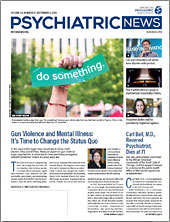The cycle of events accompanying mass shootings has become all too familiar: the 24-hour media coverage, shock and grief, vigils and funerals. Also familiar are the inevitable, inaccurate, and misleading claims, made often before any facts are known, that the mass shooting must have been committed by someone with mental illness. The negative stereotype of people with mental illness as inherently violent and dangerous makes such assertions plausible. But blaming those with mental illness for mass shootings increases stigmatization, rarely results in increased mental health funding, and does not affect the increasing rates of gun homicide.
n 2017, firearms killed 39,773 people, a record high. Firearm homicides constitute about one-third of firearm deaths; more than 75% of these occur in the context of interpersonal violence. Mass shootings still account for less than 2% of all firearm deaths, although this fact is no comfort to the surviving victims, traumatized bystanders, and grieving families. Regardless, less than 5% of all violence, not just gun violence, is attributable to mental illness. When people with mental illness have access to firearms, they are much more likely to shoot themselves than anyone else. Two-thirds of all gun deaths are suicides. Mental illness is not more prevalent here than anywhere else in the world. Yet our rates of mass shootings and firearm homicides vastly exceed those of any economically or developmentally comparable country. A minority of mass shooters are psychotic; more are angry, in crisis, or driven by hatred—conditions that do not constitute a mental illness. Moreover, the United States does not have more people who are angry or hate filled or invested in extremist ideologies than other countries.
What we do have, by far, is more guns. In 2017, around 46% of all 857 million guns in civilian hands around the world belonged to people living in the United States, according to the 2018 Small Arms Survey report, “Estimating Global Civilian Held Firearms.” The U.S. rate of gun ownership is about 120 guns per 100 people, more than one for every person in the country. Gun ownership per capita in the United States is more than six times higher than rates in Sweden, France, or Germany. The scientific consensus regarding gun violence is clear. Access to firearms in the home increases the risk of firearm homicide, suicide, and unintentional death for all members of the household, not just the gun owner. States that have stronger gun laws have fewer gun deaths. States with weaker gun laws have more gun deaths. Even geographic differences in rates of firearm suicide are better accounted for by differences in levels of household gun ownership than by differences in mental health or suicidal ideation. If we want to decrease the epidemic of gun violence, we must elect people who acknowledge the evidence supporting the use of universal background checks, closing the gun-show and boyfriend loopholes, banning military-style assault weapons, and limiting ammunition clips. Many of these interventions are supported by majorities of the American public.
Psychiatrists should also be aware of “red flag” laws, also referred to as gun violence restraining orders (GVROs) or extreme risk protection orders (ERPOs) (
Psychiatric News). These laws, modeled on domestic violence restraining orders, allow family members—and in some states others including mental health professionals—to petition a court for an emergency order allowing law enforcement to separate an individual in crisis, whether that individual has a mental illness or not, from his or her firearms. Like domestic violence restraining orders, a temporary order can be issued “ex parte,” that is, without the respondent present. However, within a specified number of days, usually about a week, a hearing with both parties present must be held, and the respondent receives full due process. If the court grants the final order, the individual will not be allowed access to firearms for a specified amount of time, usually a year. At the end of that time, the order expires unless a petitioner attempts to renew it.
Seventeen states and the District of Columbia have enacted ERPO laws, according to the Giffords Law Center. Many more states and the federal government have pending ERPO legislation. The advantages of these laws include empowering family members, who often are the first or only people aware that a loved one is in crisis, to take action to try to save lives.
Firearms are the most common means used in suicide deaths. Of firearm homicides, about 75% are nonstranger, interpersonal homicides, often in the context of domestic violence. In addition, granting an ERPO petition is not dependent on whether the respondent has a mental illness or history of mental illness. ERPOs therefore do not stigmatize individuals with mental illness.
Can ERPO laws prevent mass shootings? Maybe, to the extent that many mass shooters are also suicidal and do not intend to survive their murder sprees. Research on ERPOs indicates that they can be effective, particularly in preventing firearm suicide, according to Jeffrey Swanson, Ph.D. (Psychiatric Services, August 5). For this reason alone, psychiatrists in states that do not have ERPOs should consider advocating for such legislation.
Psychiatrists who live in states with ERPO legislation should familiarize themselves with their state’s ERPO provisions and educate patients and their families. In some locales, such as Maryland, Hawaii, and the District of Columbia, mental health professionals are able to initiate these petitions. In New York, school administrators are able to do so. Most states allow family members to obtain an ERPO, but some states allow only law enforcement agencies to file for an ERPO. In addition, states have differing requirements for the evidence that must accompany an ERPO petition.
ERPOs can be an additional tool that patients or their concerned others can use to save their loved one’s life if their treating psychiatrists understand how to use them. Mass shootings terrorize us because they occur in places that make up the fabric of our daily lives. But the problem of gun violence is much more complex than typically portrayed in the media. Many interventions will be needed to begin to combat the epidemic of gun violence, including firearm suicide. Psychiatrists and other physicians should consider gun violence a public health crisis and advocate for evidence-based interventions, such as ERPOs, to prevent harm to our patients and to others. ■
“Estimating Global Civilian-Held Firearms Numbers” is posted
here. “Association of Physician Organization–Affiliated Political Action Committee Contributions With U.S. House of Representatives and Senate Candidates’ Stances on Firearm Regulation” is posted
here. “Understanding the Research on Extreme Risk Protection Orders: Varying Results, Same Message” is posted
here.


